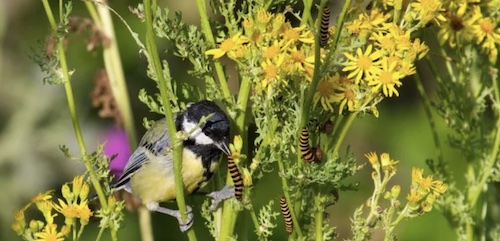We all tend to have a knee-jerk reaction when we see a field of ragwort. Most of us regard it as a squalid poisonous weed which spreads like wildfire and until recently it would be difficult to find anyone with a good word for it. But why is that and where does it come from?
Here are just a few of the things we say:
- It’s toxic to horses and cattle;
- It spreads like wildfire;
- Ragwort honey is vile and it’s toxic to humans.
Anyone who has read Isabella Tree’s book ‘Rewilding’ will have come across a chapter entitled ‘Living with the Yellow Peril’ where she goes into great detail about Ragwort – what is true and what is untrue.
Yes, it is toxic to horses and cattle but it has a horrible taste and they will not eat it in its green state unless there is overgrazing and they have nothing else to eat or when it is chopped up and included in silage or hay in which case it loses it’s obnoxious taste. But they need to eat a lot of it to experience toxic effects ie 5-25% body weight for cattle and horses.
It doesn’t quite spread like wildfire – or not in the way we are led to believe. Yes the seeds are carried on windblown fluff but most fall quite close to the parent plant. The fluff that can be seen blowing further afield tends to fly further because there are no seeds attached to it. However, the seeds can survive up to 10 years in the soil’s ‘seed bank’ and if the ground is disturbed – or overgrazed – and the soil surface is exposed then there can be a population explosion as many seeds all germinate at once. Overgrazing again.
Ragwort honey is rare. Only once in my 22 years of beekeeping have I seen a quantity of ragwort honey. It is easy to see because it is bright yellow and it is a bit vile, it’s got that obnoxious, rank smell and a bitter after-taste. They say the bitter taste fades in time and that might be true but I just gave it back to the bees. I sort of doubt ragwort honey is poisonous though.
But here is the good news:
There are 3 native species of ragwort in Ireland – plain ragwort, Buachalán buí (Senecio jacobaea), marsh ragwort, Buachalán corraigh (Senecio aquaticus) and hoary ragwort – Buachalán liat or (Senecio erucifolius). There is also the introduced Oxford ragwort, Buachalán Pheadair (Senecio squalidus). In Scotland they call it Stinking Willie.

For insects it is a most valuable plant – 7 species of beetle,12 species of flies, one macromoth – the handsome red and black Cinnabar (see below) – and 7 micromoths are entirely dependent on ragwort. It is a valuable source of nectar and pollen for 30 species of solitary bee,18 species of solitary wasps and 50 insect parasites. In total 177 insect species dine out on ragwort. These figures come from Ms Tree’s book which is about an estate in the south of England so they will be a bit different here in Ireland but the general message is clear – especially nowadays where we know that our biodiversity is shrinking daily and insect popluations are crashing – ragwort needs to be cherished a bit more and blamed rather a lot less. Perhaps we should instead be frowning on overgrazing and encouraging something less intensive.
Click here for more information about ragwort
Copyright © Beespoke.info 2021. All Rights Reserved.
